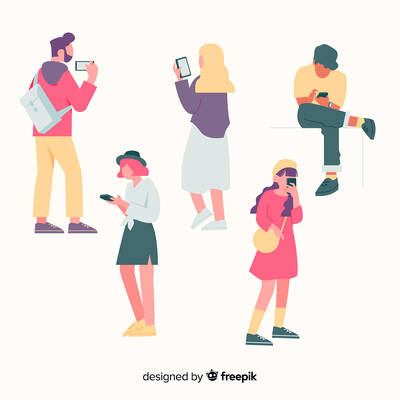對話 Dialogue
小實:馬克,你昨晚沒睡好嗎?
Xiǎoshí: Mǎkè, nǐ zuó wǎn méi shuì hǎo ma?

馬克:我已經失眠好幾天了,頭好痛喔!
Mǎkè: Wǒ yǐjīng shīmián hǎo jǐ tiān le, tóu hǎo tòng ō!
小實:失眠和頭痛都是常見的「文明病」啊。
Xiǎoshí: Shīmián hàn tóutòng dōu shì chángjiàn de “wénmíng bìng a.
馬克:文明病?是指現代人特有的疾病吧!
Mǎkè: Wénmíng bìng? Shì zhǐ xiàndài rén tèyǒu de jíbìng ba!
小實:是啊!現代人生活壓力太大了。
Xiǎoshí: Shì a! Xiàndài rén shēnghuó yālì tài dà le.
馬克:我聽說很多人還有「3C眼」,這也是常見的文明病吧?
Mǎkè: Wǒ tīng shuō hěnduō rén hái yǒu `3C yǎn’, zhè yěshì chángjiàn de wénmíng bìng ba?
小實:沒錯,用手機或電腦的時間太長了,就會造成視力退化!
Xiǎoshí: Méicuò, yòng shǒujī huò diànnǎo de shíjiān tài cháng le, jiù huì zàochéngshìlì tuìhuà!
馬克:看來現代科技不只帶來進步,也帶來了新的煩惱!
Mǎkè: Kàn lái xiàndài kējì bùzhǐ dài lái jìnbù, yě dài lái le xīn de fánnǎo.
翻譯 Translation
Xiaoshi: Mark, didn’t you sleep well last night?
Mark: I have been suffering from insomnia for several days and I have a terrible headache.
Xiaoshi: Insomnia and headaches are common ”diseases of civilization.”
Mark: “Diseases of civilization?” Are those illnesses unique to people in modern times?
Xiaomi: That’s right. Modern life is really stressful.
Mark: I heard that many people also have “3C eyes.” Is this also a typical disease of civilization?
Xiaomi: Yes, using mobile phones or computers for too long can cause vision degradation.
Mark: It seems that modern technology not only brings progress, it also brings new problems.
單字片語 Vocabulary
1. 失眠 (shīmián) insomnia
2. 頭痛 (tóutòng) headache
3. 文明病 (wénmíngbìng) disease of civilization
4. 疾病(jíbìng) disease
5. 現代 (xiàndài) modern
6. 壓力 (yālì) pressure
7. 視力 (shìlì) vision
8. 退化(tuìhuà) degenerate
9. 科技 (kējì) science and technology
10. 煩惱 (fánnǎo) trouble
教材音檔 Audio Files
教材影片 Video Files:
https://www.instagram.com/celc.nou_tw/guide/_/17999106352646292/
實踐大學華語中心提供
By Shih Chien University Chinese Language Center: https://chineseusc.com/

It often starts with a text message asking if you are available on weekends, looking for a part-time job or you get a simple “hello” from an unknown number. Halfway across the world, a laborer is usually pulling in 12-16 hour days, sending non-stop messages, hoping someone will take the bait. The ultimate goal is always to take your money — victims have lost tens of billions to scams and hundreds of thousands of people are in forced labor to keep the schemes going. These workers are often housed in massive complexes scattered across Southeast Asia, where the industry has flourished. Here

Have you ever argued with your parents about politics, news or social issues? Maybe you think their opinions are outdated, while they claim you have been brainwashed by the Internet. The truth is, neither of you is wrong. You’re simply living in different “filter bubbles,” seeing entirely different versions of reality. A filter bubble forms when Web sites use algorithms to predict what content you want. Based on the videos you watch on YouTube, the TikToks you linger on or the articles you click, the system feeds you more of the same. Before you know it, you’re stuck in

A: Hit K-pop girl group Twice is going to stage a concert at the Kaohsiung National Stadium this weekend. B: And this will be Twice’s first show in Taiwan since their debut about 10 years ago. A: After conquering fans around the world, Taiwanese member Chou Tzu-yu is finally returning to her hometown. B: Member Na-yeon actually performed at the 7-Eleven Kaohsiung Beer Rock Festival in July. Jeong-yeon, Jih-yo and Chae-young also caused a global sensation by singing the megahit “Takedown” from Netflix’s animated blockbuster “KPop Demon Hunters.” A: We’re so lucky to see all nine members performing in Taiwan for the very first

A: Apart from Twice, hip-hop trio Black Eyed Peas, a folk music festa, Japanese virtual singer Hatsune Miku, and K-pop boyband NCT will all visit Taiwan. B: Black Eyed Peas once rocked Taiwan in 2006. I love their hits, such as “I Gotta Feeling,” “Boom Boom Pow” and “Where Is The Love?” A: The upcoming Taipei Dome Eastwave festa celebrating 50 years of folk music sounds like fun, too. B: The seven-hour-long concert is scheduled from 3pm to 10pm on Saturday. A: I hear over 60 artists are going to perform more than 100 unforgettable classic folk songs. A: